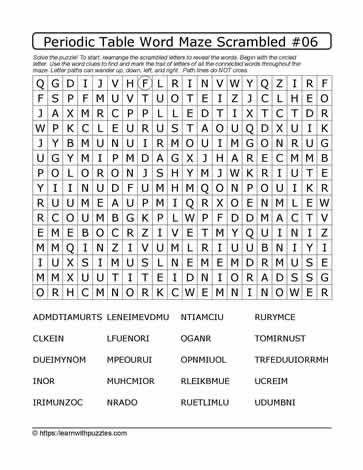Periodic Scrambled Maze#06( |
Looking for lesson plan activities and resources to engage students in a fun and interactive way? This periodic table of elements scrambled letters word maze puzzle activates students' critical thinking skills. List of 20 periodic elements' letter paths create a maze like structure within the grid. Letters in the word clues travel: forwards, backwards, up and down, but not diagonally. To solve the puzzle, letters first need to be unscrambled.
Solve the puzzle:
1. REARRANGE the letters to reveal words hidden in the grid. Record the correct spelling. This supports ease of solving the puzzle.
2. LOCATE the circled letter (in this case, the letter |F|). This is where the maze starts.
2. TRACE the letter path of the first word. Remember that letter paths travel up, down, forwards and backwards, but not diagonally. Paths do not cross.
3. Word paths track continuously from the first letter of the first element to the last letter of the last element.
4. Students ENGAGE critical thinking skills and activate problem solving strategies to determine the next word, based on letter clues and the number of words starting with the same letter!
5. TRACK progress by checking off the word clues as they are found
Resource ideas can include:
1. ENCOURAGE independent, self-directed learners: provide students with blank word search grids, located here: blank word search grids. Have them CREATE unique word search puzzles to share with others to solve, using either this list of word clues, or a unique list designed from the elements of the periodic table.
2. CHALLENGE students to create other puzzle types: cryptolists, crosswords, freeform and crosspatch puzzles, multiple choice puzzles, cryptograms. Encode the cryptogram using either: 1) a letter for letter substitution, or 2) an alphanumeric substitution.
3. ENGAGE students' critical thinking skills: get them to ORGANIZE list of elements by: 1) stability or instability of elemental isotopes, 2) toxicity levels (ordered from least to most, or most to least), 3) atomic number/weight/mass, 4) period, 5) group, 6) ancient/modern, 7) any other category you can think of.
Benefits of solving puzzles:
1. activates problem solving strategies
2. engages critical thinking skills
3. engages the brain

